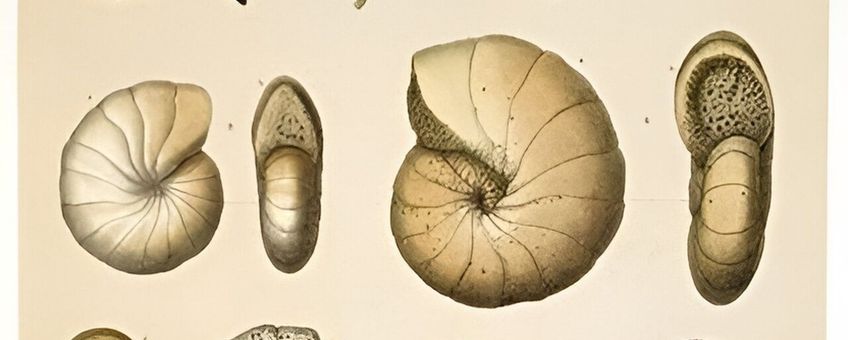
Calcifying algae as key players in climate models
NIOZ Royal Netherlands Institute for Sea ResearchLennart de Nooijer: “If we understand these mechanisms better, we might also be able to predict how the calcium balance in the oceans is going to change under the influence of the changing climate. Even though they are tiny, the seemingly endless quantities of these single-celled organisms in the oceans have an impact on the carbon cycle of the entire planet that can actually be measured.”
Evolution of a good concept
 The single-celled organisms De Nooijer studies, are so-called foraminifers. They are algae named after the little holes – foramina in Latin – that many species have in their tiny shells. “Those calcareous shells appear to be a typical case of so-called convergent evolution,” De Nooijer discovered. “The best-known example of convergent evolution is the wings that both birds and insects have developed during evolution. Both groups lack a common ancestor with wings, but in evolution both ‘came up with the good concept’ to fly with wings, completely independently of each other. Similarly, six different groups of foraminifers once started making calcium shells around their cell.”
The single-celled organisms De Nooijer studies, are so-called foraminifers. They are algae named after the little holes – foramina in Latin – that many species have in their tiny shells. “Those calcareous shells appear to be a typical case of so-called convergent evolution,” De Nooijer discovered. “The best-known example of convergent evolution is the wings that both birds and insects have developed during evolution. Both groups lack a common ancestor with wings, but in evolution both ‘came up with the good concept’ to fly with wings, completely independently of each other. Similarly, six different groups of foraminifers once started making calcium shells around their cell.”
From porcelain to chunks of lime
If you look closely, you can see essential differences between the six groups of foraminifers in the lime shells. De Nooijer: "The miliolids make shiny shells that almost look like porcelain. The nodosarids, on the other hand, make relatively coarse structures that look like porous blocks of lime under the microscope. The carterinids stick endless ovals together, which again look beautiful under the microscope." Within a group, the variation can also be enormous, De Nooijer knows. “The rotalids, for example, vary from miniature snail shells to a kind of fan, but all around a single cell.”
Calcium skeleton to grow
Why foraminifers make those calcareous shells, De Nooijer dares not say. “There is this hypothesis that it has to do with the discharge of calcium, which is very abundant in seawater, but which any living creature doesn't want to have too much of in their cells. Maybe these algae discharge their excess calcium in the form of chalk. But in the meantime, I think that the algae also benefit from that calcium shell. In distant evolutionary history, for example, there was a foraminifer that could grow as large as ten centimeters with its single cell. If you grow bigger, you may have an evolutionary advantage over other algae, but that only works if you have a sturdy external skeleton to support you,” De Nooijer thinks.
Learning from history
Apart from answering the interesting ‘why’, De Nooijer sees a very practical application of this knowledge about the calcareous shells of his algae. “By scouring all the literature on these organisms, I found six moments in history when foraminifers started forming shells.  The amounts of calcium, CO2, magnesium and other chemical substances in the water, as well as the temperature, varied considerably between those six periods in history. Thus, by looking at the different foraminifers in a particular layer of sediment, we can learn a lot about the environmental conditions at a particular time. But conversely, we can also try to predict how the foraminifers will change under changing conditions, for example due to increasing temperatures and CO2 in the ocean water.”
The amounts of calcium, CO2, magnesium and other chemical substances in the water, as well as the temperature, varied considerably between those six periods in history. Thus, by looking at the different foraminifers in a particular layer of sediment, we can learn a lot about the environmental conditions at a particular time. But conversely, we can also try to predict how the foraminifers will change under changing conditions, for example due to increasing temperatures and CO2 in the ocean water.”
Carbon accounting
De Nooijer is not at all worried about, for example, the upcoming extinction of certain foraminifers due to the changing climate. “But changing the composition of all these algae, does have a huge impact on the calciforous and CO2 balance of the oceans. For example, while forming shells, the algae themselves emit CO2. So, we will never fully understand the complete carbon accounting of the oceans if we don't understand how these foraminifers deal with calcium and CO2.”
Conflicting results
In the past, with the help of laboratory experiments, more attempts have been made to understand the influence of CO2, temperature and calcium on foraminifers, and thus on the entire ocean. “These experiments always produced very contradictory results,” De Nooijer observed. "Now I better understand why: there are very different strategies within this one group of algae that all require their own conditions.”
The penny didn't drop for de Nooijer until he was forced to work from home during the covid pandemic. “Only then did I have the peace and time to lump together all the literature on this group of algae and look for connections.”
Text: NIOZ
Figures: Wyville Thomson, Voyage of H.M.S. Challenger 1873-1876. Zoology Vol. 9 Foraminifera, 1884
